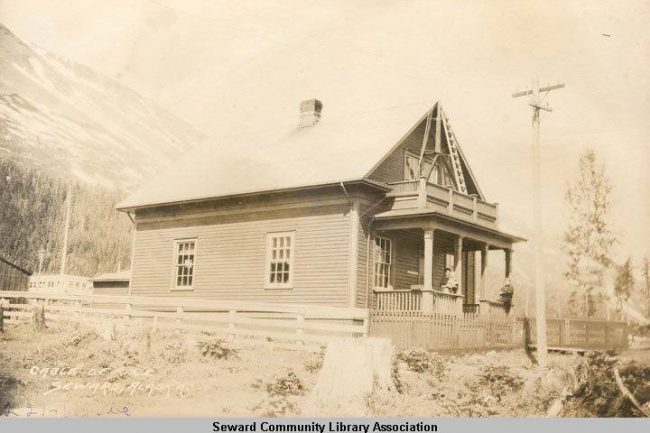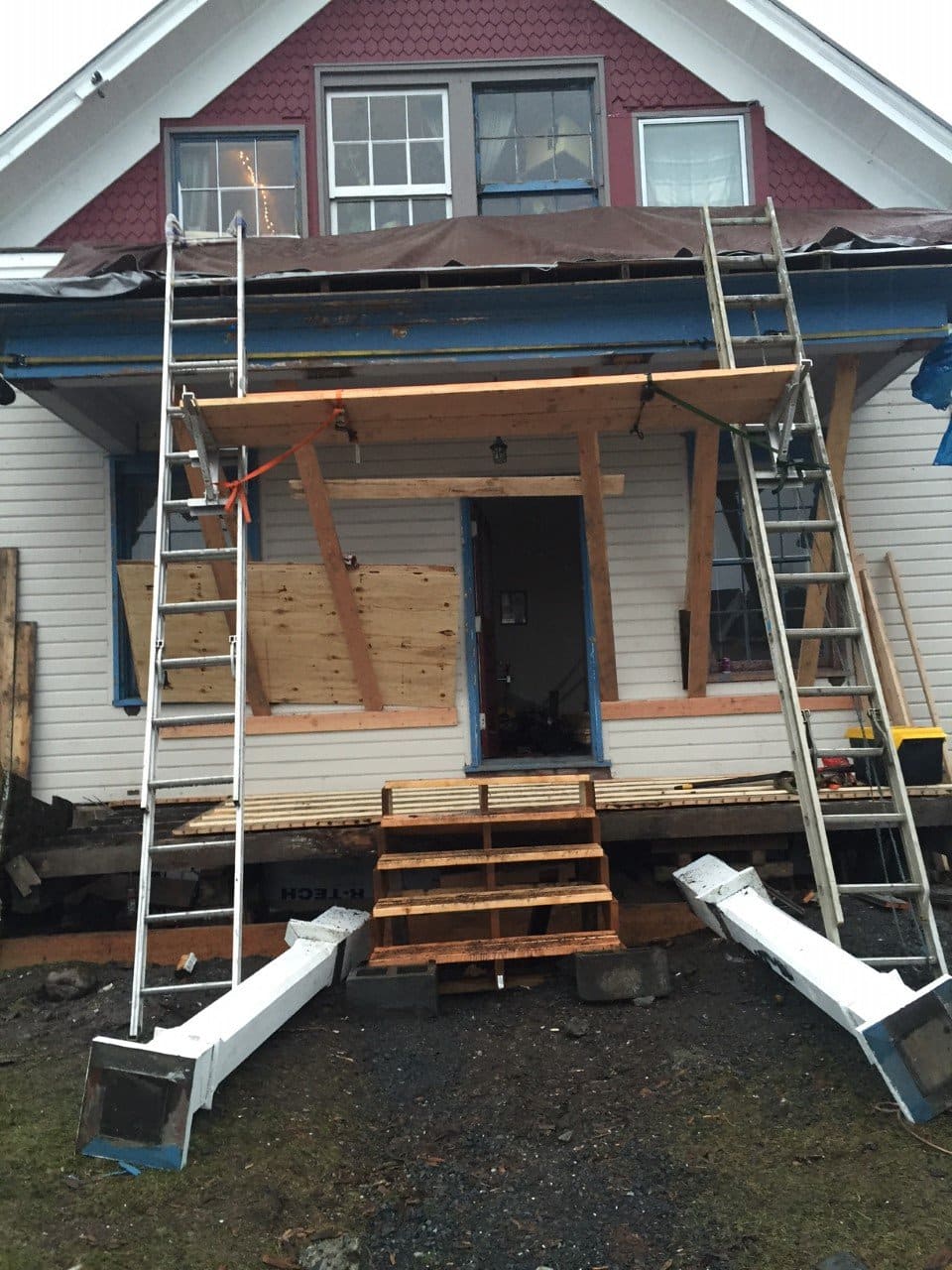
1908 view of the Seward Cable House by Sylvia Sexton. Photo courtesy of the Seward Community Library Association SCLA-1-135
By Tanguy Libbrecht
The “Govt. Cable House” located on 6th Ave is in the original Seward tract where the Ballaine brothers first envisioned that Seward would become a large bustling city. They and their contemporaries dreamed Seward would the Capitol of Alaska, attracting investors, families, and visitors from all over the world to see what they excitedly envisioned as a new “Chicago West” or the “New York of the Pacific” (Capra).
For many years, my wife and I were drawn inexplicably to the large, blue “remuddled” property with the distinctive front porch, overgrown trees, and crumbling façade. My wife loved the period architecture and early 1900’s details. Where I saw a home with a lilting front porch, rusted roof, sagging pillars, and a stucco exterior that seemed to be peeling away more each day, she saw only a beautiful

home that was worth preserving for our enjoyment and that of future generations. The small handmade sign with the words “Telegraph house,” the National register plaque, the Historic Seward Register emblem at the entrance all suggested that the house may have once had an important place in Seward history.
I did not have to dig deep to find out that this 1905 home was a telegraph station office that was part of the Washington Alaska Military Telegraph and Cable System. The Cable House was built and operated by the Army Signal Corps on land given to the U.S. Govt by the Ballaine brothers, prominent founders of Seward itself. Though the house is well known to local historians, very few local people paid attention to it, with very little indication of its former prominence given its appearance and the toll of the years, weather, and time.
In 2014, we contact
ed the current owners to see if they would be willing to sell us the home and thus started the great idea. How do we bring the “Cable House” back to its former glory? Where will we get the funding, the time, the expertise to complete this project?
Enter KMTA and their grant program. Like KMTA, we seek to “connect past and future.” With a $10,000 matching grant, we were able to hire a contractor to renovate the front porch and restore some of the damaged pillars and decking. Their grant program gave us the boost that eventually enabled us to pursue additional funding and grants from the State Historic Preservation Office via NPS Grants.

Our KMTA inspired signage now sits proudly in our front yard, a testament to their support of the vibrant, historically important Turnagain Arm corridor. Like KMTA, we seek to preserve the past for the future. The renovation is ongoing, and the beauty of this historic home continues to emerge, ready to share its story for future decades,
This sign and this project motivated me to join the Seward Historic Preservation Commission. Recently, the commission applied for and received a CLG grant to create a Seward walking tour that will connect sites of interest through interpretive signs. Due to the hard work and passion of fellow commissioners, both locals and visitors will soon be able to follow a walking tour that will likely stoke their interest in Seward, and hence their interest in Turnagain arm for decades to come. The walking tour will debut in early July, encompassing 30 plus properties. It will focus predominantly on the historic downtown area, with 25 or more points of interest that will feature a permanent narrative sign
Side note:
In the summer of 1905, a submarine cable was laid between Valdez and Seward, which connected the new town with Seattle and the rest of the United States. This communication service was immediately put to use by Frank Ballaine and the local newspaper, The Seward Daily Gateway. Beginning in August of 1905, the daily Seward newspaper began to feature next day news accounts from the continental United States. Prior to this cable connection, news arrived by mail brought by steamer. Communication was initiated August 7, 1905. The first message transmitted over the cable after it was connected was to A.C. Frost, President of Alaska Central Railway, who was in Chicago: “This first message transmitted over Alaska Cable connects Seward from this day to the great city of Chicago.”
 -Tanguy Libbrecht is originally from Brussels, Belgium, moving to the states at a young age. He met his wife Marcella at the University of Texas in Austin and the two moved to Alaska in 1994, bringing their love of old history and old homes with them. Around 2007, they bought their first historic home in Seward (1913) and just a few years later acquired the cable house (1905) Both are very involved with hands in renovation of their properties. Tanguy and Marcella have four children all born in Alaska. Tanguy is the CEO of the American Red Cross for Alaska and Marcella is the project manager and creative designer for renovations and as president of the business, runs to the day to day of the houses which serve seasonally as vacation rentals.
-Tanguy Libbrecht is originally from Brussels, Belgium, moving to the states at a young age. He met his wife Marcella at the University of Texas in Austin and the two moved to Alaska in 1994, bringing their love of old history and old homes with them. Around 2007, they bought their first historic home in Seward (1913) and just a few years later acquired the cable house (1905) Both are very involved with hands in renovation of their properties. Tanguy and Marcella have four children all born in Alaska. Tanguy is the CEO of the American Red Cross for Alaska and Marcella is the project manager and creative designer for renovations and as president of the business, runs to the day to day of the houses which serve seasonally as vacation rentals.
Side note reference: http://www.cityofseward.net/hpc/historic_properties/us_cable_office.shtml.htm
Doug Capra reference: “Chicago West: Seward in 1903-1905 (copyright 2008)
